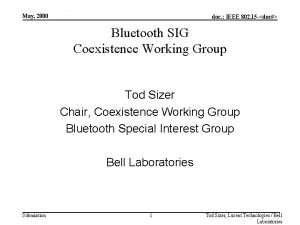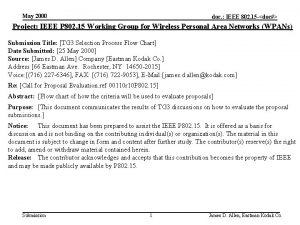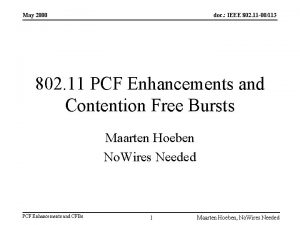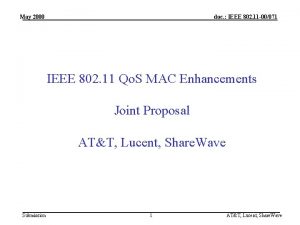May 2000 doc IEEE 802 11 00127 IAPP






- Slides: 6

May 2000 doc. : IEEE 802. 11 -00/127 IAPP handover scenarios Gary Spiess Submission 1 Gary Spiess, Intermec Technologies

May 2000 doc. : IEEE 802. 11 -00/127 Necessary and sufficient and handoff sequence (baseline) 1) Station issues association request to new AP. 2) New AP sends the association response to the station. 3) New AP sends multicast handover request to old AP. 3 4) If Old APs association with the station is younger than a handover hold-down period (e. g. 5 seconds), New AP the Old AP sends disassociation to station. If old association is older, disassociation has no benefit. • Potential errors -Handover request is lost • Benefits -No handover response -Can be adapted to non 802. 11 stations -Handover request heard by all in broadcast domain • Drawbacks -Handover blocked by routers Submission 2 Old AP 2 4 1 Station Gary Spiess, Intermec Technologies

May 2000 doc. : IEEE 802. 11 -00/127 Using an alert to recover from a lost handover 1) Old AP discards a frame for a station, which should have responded. Since it queued the frame for the station, it saw no frame from the station (no control, data, or management). 2) Old AP includes station in list of potentially lost handovers in a multicast announce frame (an alert). This is rate limited to prevent announce storms. 3) Any AP that has an association with the station regenerates a handover that needs no response. 2 3 New AP Old AP 1 Station • Advantages -Heals the system shortly after an old AP receives traffic destined to a station for which it missed the handover. • Disadvantages -False alerts will happen (could be considered diagnostic information) Submission 3 Gary Spiess, Intermec Technologies

May 2000 doc. : IEEE 802. 11 -00/127 Handover with optional response from old AP 3) Old AP makes a unicast response to a handover request from the new AP. 4) New AP waits for old AP response before sending association response to station. 2 3 New AP Old AP 4 • Additional potential errors from baseline -Handover response is lost or obsolete • Additional benefits from baseline -Transfers useful station information from old AP, e. g. , Qo. S parms (migratory database) • Additional drawbacks from baseline -Delay (or failure) of response to station due to handover response Submission 4 1 Station Gary Spiess, Intermec Technologies

May 2000 doc. : IEEE 802. 11 -00/127 Handover with optional response from regional database 2) Regional DB sees multicast handover request from new AP requesting information from the regional database. 3) Regional DB makes a unicast response to the handover request from the new AP. 4) New AP waits for Regional DB response before sending association response to station. • Additional potential errors from baseline -Regional DB response is lost or obsolete • Additional benefits from baseline -Transfers useful station information from Regional DB, e. g. , Qo. S parms • Additional drawbacks from baseline -Delay (or failure) of response to station Submission 5 3 Regional DB 2 New AP Old AP 4 1 Station Gary Spiess, Intermec Technologies

May 2000 doc. : IEEE 802. 11 -00/127 Summary of changes • Allow handover request to be multicast as well as unicast – Not trusting station to provide old AP address for unicast • Allow handover to include optional requests for specific information from a regional database and/or old AP – Supports regional and/or migratory database – Possible to implement things like Qo. S handover – Handover responses from the regional DB or old AP are not necessary unless responding to requested information • APs identify possible handover races when handover is received – must actively disassociate if own association is younger than hold-down – may passively disassociate if own association is older than hold-down – Cures obsolete handovers • Allow any AP to solicit a handover request with an “alert” – Cures lost handovers Submission 6 Gary Spiess, Intermec Technologies











